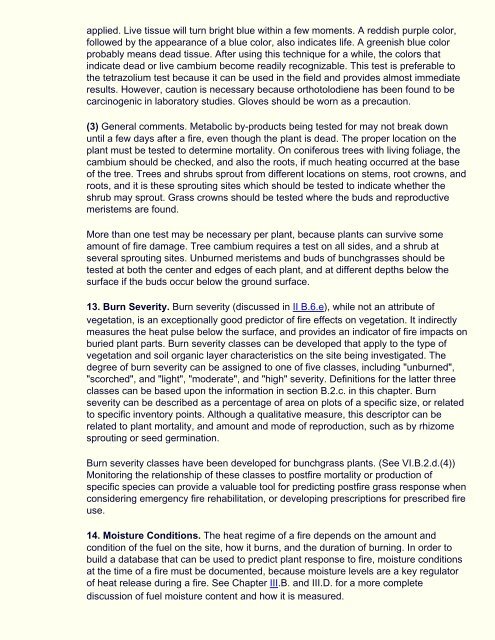FIRE EFFECTS GUIDE - National Wildfire Coordinating Group
FIRE EFFECTS GUIDE - National Wildfire Coordinating Group
FIRE EFFECTS GUIDE - National Wildfire Coordinating Group
Create successful ePaper yourself
Turn your PDF publications into a flip-book with our unique Google optimized e-Paper software.
applied. Live tissue will turn bright blue within a few moments. A reddish purple color,<br />
followed by the appearance of a blue color, also indicates life. A greenish blue color<br />
probably means dead tissue. After using this technique for a while, the colors that<br />
indicate dead or live cambium become readily recognizable. This test is preferable to<br />
the tetrazolium test because it can be used in the field and provides almost immediate<br />
results. However, caution is necessary because orthotolodiene has been found to be<br />
carcinogenic in laboratory studies. Gloves should be worn as a precaution.<br />
(3) General comments. Metabolic by-products being tested for may not break down<br />
until a few days after a fire, even though the plant is dead. The proper location on the<br />
plant must be tested to determine mortality. On coniferous trees with living foliage, the<br />
cambium should be checked, and also the roots, if much heating occurred at the base<br />
of the tree. Trees and shrubs sprout from different locations on stems, root crowns, and<br />
roots, and it is these sprouting sites which should be tested to indicate whether the<br />
shrub may sprout. Grass crowns should be tested where the buds and reproductive<br />
meristems are found.<br />
More than one test may be necessary per plant, because plants can survive some<br />
amount of fire damage. Tree cambium requires a test on all sides, and a shrub at<br />
several sprouting sites. Unburned meristems and buds of bunchgrasses should be<br />
tested at both the center and edges of each plant, and at different depths below the<br />
surface if the buds occur below the ground surface.<br />
13. Burn Severity. Burn severity (discussed in II B.6.e), while not an attribute of<br />
vegetation, is an exceptionally good predictor of fire effects on vegetation. It indirectly<br />
measures the heat pulse below the surface, and provides an indicator of fire impacts on<br />
buried plant parts. Burn severity classes can be developed that apply to the type of<br />
vegetation and soil organic layer characteristics on the site being investigated. The<br />
degree of burn severity can be assigned to one of five classes, including "unburned",<br />
"scorched", and "light", "moderate", and "high" severity. Definitions for the latter three<br />
classes can be based upon the information in section B.2.c. in this chapter. Burn<br />
severity can be described as a percentage of area on plots of a specific size, or related<br />
to specific inventory points. Although a qualitative measure, this descriptor can be<br />
related to plant mortality, and amount and mode of reproduction, such as by rhizome<br />
sprouting or seed germination.<br />
Burn severity classes have been developed for bunchgrass plants. (See VI.B.2.d.(4))<br />
Monitoring the relationship of these classes to postfire mortality or production of<br />
specific species can provide a valuable tool for predicting postfire grass response when<br />
considering emergency fire rehabilitation, or developing prescriptions for prescribed fire<br />
use.<br />
14. Moisture Conditions. The heat regime of a fire depends on the amount and<br />
condition of the fuel on the site, how it burns, and the duration of burning. In order to<br />
build a database that can be used to predict plant response to fire, moisture conditions<br />
at the time of a fire must be documented, because moisture levels are a key regulator<br />
of heat release during a fire. See Chapter III.B. and III.D. for a more complete<br />
discussion of fuel moisture content and how it is measured.
















